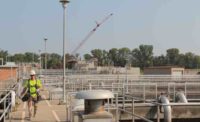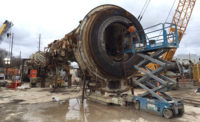The tunnel boring machine looks fairly modern, but it is actually more than 35 years old. Rebuilt shortly after churning its way through the Second Avenue Subway in New York City, the 450-ft-long Robbins main-beam TBM is now taking a spin through subterranean Indianapolis as part of the Circle City's $1.6-billion, 20-year plan to control its combined sewer overflows.
"It's very unusual for a TBM to finish up and go right to another job," explains Stuart Lipofsky, project manager for S-K JV—a joint venture of Walnut, Calif.-based J.F. Shea Construction Co. Inc. and Omaha, Neb.-based Kiewit Corp.—and general contractor on the city's Deep Rock Tunnel Connector. "Usually, it sits in the yard and looks like junk."
The 1.2-million-lb TBM is a key item on the critical path to completing the connector, an eight-mile, 20.2-ft-dia tube that workers are drilling through limestone and dolomite 250 ft below the city. Working around the clock under a $179.3-million contract for Citizens Energy Group, S-K is off to a solid start: So far this year, its tunnelers have bored out more than two miles, including a world-record-breaking daily drive of 409 ft. When completed—the schedule says fall 2017—the DRTC, costing $234 million in total, will connect a 25-mile-long system of rock tunnels and drop shafts. They will channel waste to treatment plants, which are being upgraded to handle the increased flow.
"The biggest challenge is coming to do a deep-rock tunnel where no deep-rock tunnel has been done before," says Lipofsky. "Not knowing what's really down there—even though we've got our borings—from design to construction management, it's all a first."
Like many cities across the country, much of Indianapolis is built on top of combined wastewater and storm sewers. Under heavy rain, the system is often overloaded, dumping about 7.8 billion gallons of sewage per year into local rivers and streams. Situated between two treatment plants, the DRTC, coupled with four other planned tunnels, will be able to store 250 million gallons. Together, they will help reduce annual discharge to less than 414 million gallons of sewage, a capture rate of about 95%. For designers and contractors, the work also sets the stage for more than a decade of heavy construction throughout Indianapolis.
The DRTC is the biggest wastewater project ever let in the city, according to John Morgan, manager of special projects for Citizens Water, a unit of CEG. Standing on the 15-acre launch site near the Southport Advanced Wastewater Treatment Plant, on the city's south side, he explains that this tunnel is the easy part.
"This is the biggest site we'll ever have for a tunnel," Morgan explains. "Our retrieval shaft is less than one-quarter the size of this, and that will be our next launch shaft. As we get more metropolitan, and as we go more upstream in the system, it just keeps getting tighter."
Work around the Southport launch shaft is busy but organized. Dump trucks are continuously driving into the site empty and leaving full of rock, muck and other material, which a conveyor heaps onto a massive pile next to the 251-ft-deep launch shaft. The trucks proved a bigger nuisance than the tunneling, whose early work required explosive emulsions. (Project engineers prefer to describe the work as "drill and shoot," a softer-sounding expression.) "We were getting complaints about the tailgates slapping, which we took care of over time," says Morgan. "But never did we get a complaint about the blasts."
S-K clinched the job from a highly competitive pool of nine bidders and began work in December 2011. "Like every tunnel job, the first thing we do is set up our utilities," says Lipofsky, adding, "it was a grass field when we got here." The owner gave the contractor the option of hooking up the TBM's 13.2-kV electrical lifeline to the nearby treatment plant. For an extra $1 million, it also had the option of running a line from a nearby substation. Fortunately for both parties, the plant's own power was sufficient.
While S-K was preparing the site, crews at J.F. Shea's yard in Mount Pleasant, Pa., were busy rebuilding the TBM, which came off duty from the Second Avenue Subway in November 2011. The cutterhead was built new at Robbins' facility in Akron, Ohio. The machine, originally built in 1976, was upgraded with variable-frequency drive motors, a back-loading cutterhead with 19-in. discs and other modern equipment.







Post a comment to this article
Report Abusive Comment